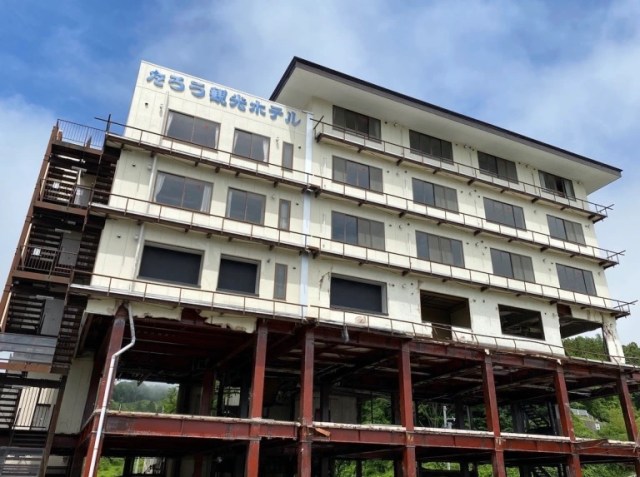
This preserved Tohoku building goes from completely devastated to practically unharmed in just a few floors.
While travelling in Japan’s northeastern Tohoku region, our Japanese-language reporter Saya put the Taro Kanko Hotel on her itinerary. She wasn’t planning to spend the night, though, and even if she’d wanted to, that’s no longer an option.
That’s because the hotel, which is located in the town of Miyako, Iwate Prefecture, hasn’t been in operation since March 11, 2011. You probably remember that as the day of the 3-11 earthquake and tsunami that devastated several coastal communities in Fukushima, Iwate, and Miyagi Prefectures. The hotel was right in the tsunami’s path, and while it looked like this before the tragedy…
…it looks like this now.
These days, the Taro Kanko Hotel doesn’t receive guests looking for a place to stay. Instead, it’s become a shinsai ikou (“disaster remains”) facility, preserved in its post-tsunami state as a monument and educational location to inform people of what took place. For safety reasons, you can’t just roll up and walk on in, but the Miyako Tourism and Cultural Exchange Association offers tours of the site with a guide by prior reservation.
The first thing you notice is that the bottom two floors of the six-story building are just gone. Their walls were completely washed away on all four sides, and stepping inside shows the devastation in even starker ways. The first floor, for example, used to be where you’d find the check-in desk, lobby, and large communal baths, but now there’s nothing at all, as the tsunami gutted the interior with frightening efficiency.
Standing in the barren remains of the first floor, if you look up you’ll see there’s no longer a ceiling. That’s because when the tsunami came rushing in, it lifted the contents of the first floor upwards where they cracked and shattered the ceiling before the waves broke through the back walls and flushed everything out.
The interior staircase is warped beyond use, and the elevator isn’t operational anymore, so to get to the upper levels of the hotel you take a repaired, reinforced exterior staircase.
The second floor used to be where the hotel’s banquet rooms were. Even more so than the first floor, though, it was turned into a completely featureless slab as the interior walls, fixtures, and furnishings were swept away by the sea.
There’s a shock of the opposite variety once you get to the fourth floor, however. Once you get above the height the tsunami’s waters rose to, the hotel looks unsettlingly ordinary.
With no visible damage to the interior, it feels like any of a hundred other affordably priced regional hotels you could book a room in tonight, with nothing to indicate the terrifying destruction that happened just a few feet below.
Thankfully, the time the tsunami hit Iwate, 2:46 p.m., was after the morning check-out time but before afternoon check-in, so the hotel was largely empty of guests and no one on the premises lost their lives. However, the hotel’s owner was in the building when the tsunami came, and realizing he wasn’t going to be able to get far enough inland to escape it, he rushed to the sixth floor, the highest part of the hotel.
While taking shelter in this room, he pointed his camera out the widow and recorded a video as the tsunami rushed towards the building and struck it. While sitting in the very same room, the guide played the video for Saya.
Like everyone living in Japan, Saya has seen many, many videos of the 3-11 tsunami while watching TV news as the situation was unfolding and also in retrospective reports. But while she felt like she’s gotten used to them, this video felt different. Maybe it’s because the owner never sent his video in to any TV networks, and so she’d never seen this particular one before, but more likely it’s because she was sitting in the exact spot where it was recorded, looking out of the same window and seeing a quiet, peaceful town that can be turned into the sight of an unforgettable tragedy in just moments.
The Taro Kanko Hotel isn’t the only shinsai ikou in Tohoku, but their presence is the source of some debate among local residents. Some want them cleared away as soon as possible, saying that they reopen painful wounds whenever they have to go by them in the course of their daily lives. Others, though, feel that they should be preserved as symbols of the need for proper disaster preparedness and to remember those who lost their lives, and for now, the Miyako Tourism and Cultural Exchange Association is ready to guide those who are of the second school of thought.
Related: Miyako Tourism Cultural Exchange Association
Photos ©SoraNews24
● Want to hear about SoraNews24’s latest articles as soon as they’re published? Follow us on Facebook and Twitter.
[ Read in Japanese ]